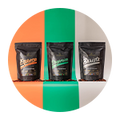Gut health plays an important role in our comfort and day to day life, having good gut health can have a positive effect on energy levels, digestion, bowel movements, and hormone production. While bad gut health can take away from these aspects, and even negatively impact them.
A good start point for improving your gut health can be to follow a low-FODMAP diet for a period of up to 6 weeks . This temporary change in diet can provide insight into foods that may be causing minor gut issues, and kick start your journey to overall improved gut-health. A low FODMAP diet has been shown to benefit existing gut issues like regular stomach aches, and complement rehabilitation regimes of gut-specific conditions like Crohn's Disease or IBS (Irritable Bowel Syndrome). As always, if you have underlying health conditions or concerns, ensure you consult your health care provider before making any changes to your diet.
WHAT IS FODMAP?
FODMAP refers to Fermentable Oligosaccharides, Disaccharides, Monosaccharides and Polyols, and a low-FODMAP diet references a reduced amount of these fermentable sugars within the gut! These naturally occurring sugars are found in the foods we commonly eat and are generally poorly absorbed within your small intestine, so a low-FODMAP diet restricts your consumption of these foods/sugars whilst also exploring which foods have a negative effect on your gut.
KEY FACTORS IN A LOW-FODMAP DIET
- This is not a permanent diet! It's a diet to explore your tolerance to naturally occurring fermentable sugars, and is not to be followed permanently (unless prescribed) as it is not always nutritionally adequate.
- FODMAPs are in everyday foods such as wheat, grains, dairy products, and some fruits and vegetables.
- Low-FODMAP diets focus on the reduction of the above mentioned foods to restrict the body's exposure to naturally occurring fermentable sugars.
- A Nutritionist or Dietitian's insight is always beneficial when considering a low-FODMAP diet, and a dietitian's oversight of a low-FODMAP diet and FODMAP exposure can also include the testing for poor absorption of FODMAPs as well as symptoms and conditions related to poor FODMAP absorption.
LOW TOLERANCE TO FODMAPs
This will occur when your body has difficulty in digesting or processing the naturally occurring sugars of Fermentable Oligosaccharides, Disaccharides, Monosaccharides and Polyols. Essentially, because of its inability to break down these sugars, your body sends signals to your brain through the symptoms that you experience with poor gut health. Generally, an individual is only intolerant towards specific FODMAPs rather than every food within all of the FODMAP categories, so identifying these food triggers will provide you with more insight into how to better manage your gut health long-term.
HOW TO EXPLORE & NAVIGATE A LOW-FODMAP DIET
This process might seem daunting, but it can actually be quite simple! Outside of testing for specific conditions related to your gut health which is overseen by a medical professional, you can start yourself on a low-FODMAP diet by reducing your exposure to specific foods including wheat, grains, dairy products, fruits, and vegetables. The list can be quite extensive, but we've broken down some examples below to provide some easily accessible guidelines for considering a FODMAP diet. The reduction in these products & foods is your first step to a low-FODMAP diet, and adhering to this diet for a timeline of 2-6 weeks will allow for your symptoms of poor gut-health to resolve. At this stage you'll want to start reintroducing specific foods in a cadence that will allow you to test which foods your body can tolerate and those that it cannot.
FOODS HIGH IN FODMAPs TO AVOID ON A LOW-FODMAP DIET
- Excess Fructose (Monosaccharides): Honey, fresh fruits such as apples, pears, watermelon etc, dried fruit, canned fruits, breakfast cereals containing dried fruits.
- GOS (Galacto-Oligosaccharides): Beans such as kidney beans; baked beans; borlotti beans etc, pistachio nuts, chickpeas, lentils, cashews.
- Dairy (Disaccharides): Milk & milk derivatives such as condensed milk; evaporated milk; & milk powders, unripened cheeses such as cottage; ricotta; mascarpone; cream etc, custard, dairy-based desserts, yoghurt, ice cream.
- Fructans: wheat, rye, barley, fruits & vegetables such as onion, white peaches, chicory, garlic, spring onion, leek and nectarines.
- Polyols: found in specific fruits & vegetables such as apricots, plums, cauliflower, mushrooms, longons, blackberries, as well as lollies/candies, specific beverages, and artificial sweeteners commonly found in products like chewing gum or sugar-free health products.
Good news is that you can still enjoy a BYS Coffee per day when following a low FODMAP diet! ☕
Disclaimer: As with any significant dietary or lifestyle change, always speak with your General Practitioner before beginning any diet regimen.
Written by: Brianna-lee - Qualified Nutritionist










